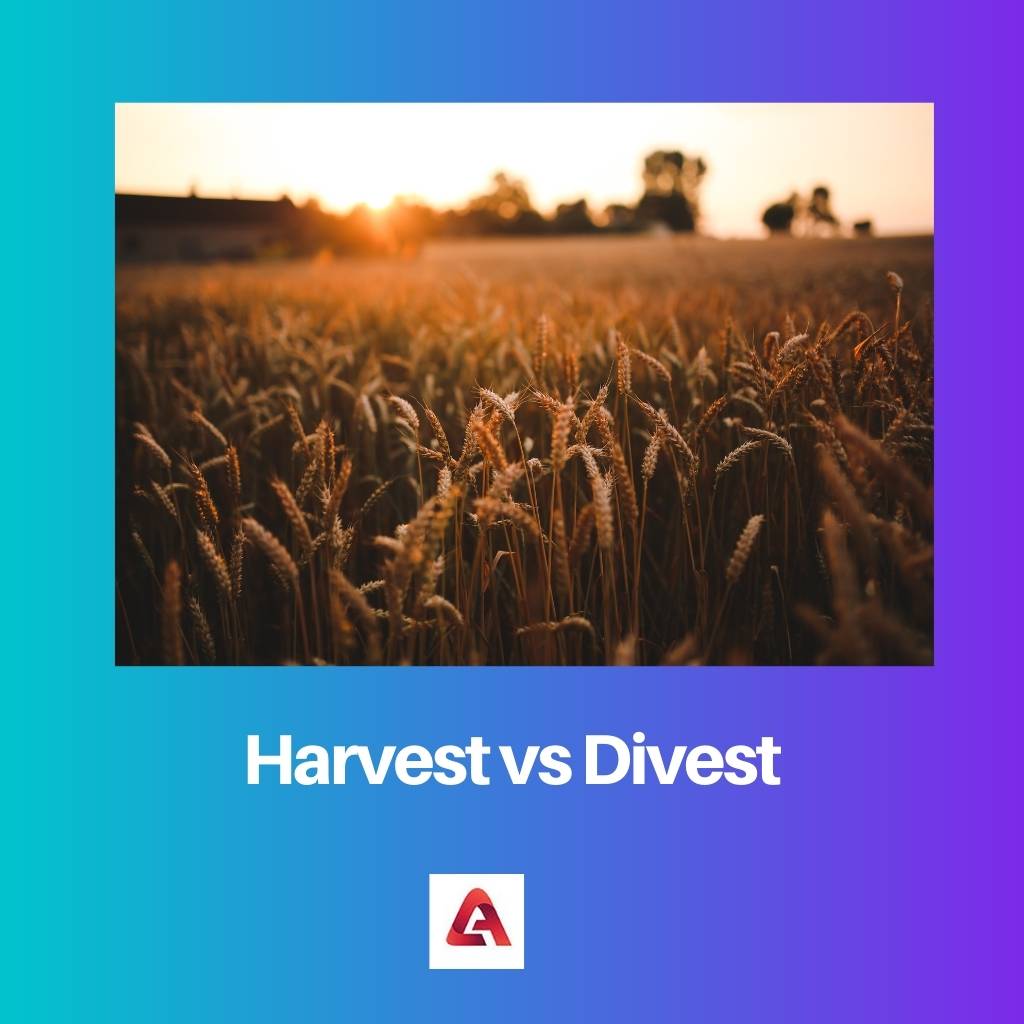Techniques such as harvest and divest are utilized to account for the fuse of current and future market development openings. Harvest is the usage of income from the offer of items at their end cycle to boost benefits.
Divest is the decrease of resources essentially for monetary, political, and moral destinations.
Key Takeaways
- Harvest refers to gathering mature crops from fields, while divesting is selling or disposing of assets, investments, or businesses.
- Harvesting is an agricultural activity, whereas divesting is financial and strategic decision individuals or organizations make.
- Both terms indicate the extraction of value or resources, but they apply to different domains—agriculture for harvesting and finance for divesting.
Harvest vs Divest
The difference between harvest and divest is that harvest is a technique including the decrease of expenditure on an item to lessen working expenses and chiefly includes obsolete items. In actuality, the divest is the decrease of resources principally for monetary, political, and moral destinations.

Harvest is the decrease or end of items, line of business, or product offering speculations to get the most extreme yields. This happens toward the finish of an item cycle when the item in the market can presently don’t be utilized to support income.
At the point when an item’s life cycle approaches its end, and perceptions are made on low returns, organizations might cut extra speculation and showcasing endeavours.
Divest technique implies selling your own resources. Organizations carry out Divest to get reserves rapidly from a business which is, in any case, not a star entertainer for the organization.
It assists with exchanging that business and gives some soundness to the organization. Divestment is essentially the auctioning off of non-performing auxiliary organizations in an association.
Comparison Table
| Parameters of Comparison | Harvest | Divest |
|---|---|---|
| Definition | Harvest is the reduction of products. | Divest is the reduction of resources. |
| Motive | Is to accomplish the greatest yields from the offer of items and administrations toward the finish of their cycle. | Is to sell organizations that are at this point don’t some portion of the significant activity, wipe out a failure to meet expectations divisions. |
| Aim | To get maximum yield. | To source funds. |
| Result | Permits organizations to acquire the most extreme benefits from the item. | To wipe out failing to meet expectations divisions. |
| Objective | The increases would then be able to be utilized in the turn of events and advancement of existing items. | Social reasons. |
What is Harvest?
Harvest methodology is a promoting and business procedure that includes a decrease or an end of interest in an item, product offering, or line of business so the elements included can procure—or reap—the greatest benefits.
A collect technique is ordinarily utilized at the finish of an item’s life cycle when it is resolved that further speculation will, at this point, don’t support item income.
Items have life cycles, and when the thing approaches the finish of its life cycle, it normally won’t profit with extra speculations and promoting endeavours.
This item stage is known as the cash cow, and it is the point at which the resource is paid off and requires no further speculation.
In this situation, utilizing a harvesting procedure will permit organizations to collect the most extreme advantages or benefits before the thing arrives at its decrease stage.
Organizations regularly utilize the returns from the consummation thing to support the turn of events and circulation of new items. Assets additionally may go toward advancing existing items with high development potential.
A harvest procedure might include the steady end of an item or product offering when mechanical advances render the item or line out of date. During harvest, the organization can restrict or kill capital costs, for example, the acquisition of new gear expected to help the closure thing.
Likewise, they can confine spending on tasks.

What is Divest?
Divestment is a type of conservation technique utilized by organizations when they cut back on the extent of their business exercises. Divestment normally includes killing a part of a business.
Firms might choose to sell, close, or spin-off an essential speciality unit, major working division, or product offering. This move frequently is the ultimate conclusion to dispense with random, unbeneficial, or unmanageable activities.
Much of the time, it isn’t promptly clear that a unit ought to be stripped. Commonly the board will endeavour to expand speculation as a method for offering the unit a chance to turn its exhibition around.
Portfolio models, for example, the Boston Consulting Group (BCG) Model or General Electric’s Business Screen, can be utilized to recognize tasks needing divestment.
Divestment isn’t the very first option to proceed for a business. Notwithstanding, as item requests change and firms modify their procedures, there will be some segment of the business that isn’t performing to the board’s assumptions.
Such activity is an ideal objective for divestment and may well leave the organization in a more grounded cutthroat position in case it is stripped.
Main Differences Between Harvest and Divest
- Harvesting is continuously decreasing all costs spent on the item where, as divesting is dropping or erasing the item from its further production.
- Harvest is to achieve the best yields from the proposal of things and organizations around the completion of their cycle. Divest is to sell associations that are now don’t some segment of the huge movement, clear out a neglecting to meet assumptions divisions.
- Harvest grants associations to gain the most outrageous advantages from the product. Divest allows crashes, neglecting to meet assumptions divisions.
- Harvest procedure suggests selling your own assets. Divest is done by associations to get holds quickly from a business that is regardless not a star performer for the association.
- Harvest has to be done at the end of the product’s life cycle. Divest has to be done when a part of the company is no more efficient.

- https://journals.aom.org/doi/abs/10.5465/255955
- https://link.springer.com/chapter/10.1007/978-1-4899-7138-8_29

The contrast between harvest and divest is clearly outlined in this article. The detailed explanations have provided great clarity on the objectives and results of each technique.
I couldn’t agree more. The article’s thorough explanations and practical examples have enhanced my understanding of these strategic concepts.
The sections on what harvest and divest are provide a great foundation for understanding their significance. The comparison table is an excellent visual representation of their differences.
I appreciate the clarity of the article. It’s been written in a way that makes these strategic techniques easy to understand.
I couldn’t agree more. The comparison table is incredibly helpful in distinguishing between harvest and divest.
This article has certainly deepened my understanding of harvest and divest. The explanations are well-crafted, and the practical examples are pivotal in making the concepts comprehensible.
The practical examples used throughout the article were incredibly beneficial. It’s made these strategic techniques much clearer.
The article provides a clear insight into the objectives and results of both the harvest and divest techniques. The practical examples help in understanding their application.
I particularly enjoyed learning about the objective of each technique. The section on social reasons for divestment was enlightening.
I agree, the practical examples definitely make the concepts more relatable. The article is well-written and informative.
The practical examples provided for both harvest and divest have been instrumental in my understanding of these concepts. The article’s detailed explanations are commendable.
The practical examples were definitely a highlight. They enriched the content and made the techniques more relatable.
The detailed descriptions of what harvest and divest are make this article highly informative. The article effectively covers the key takeaways and comparison table.
The practical examples used for both harvest and divest were incredibly useful. They made it simpler to see how these techniques are put into practice.
I found the descriptions to be quite thorough and easy to understand. The comparison table especially highlights the differences between harvest and divest.
The sections explaining what harvest and divest are serve as an excellent foundation for their differentiation. The practical examples bring these concepts to life.
The practical examples indeed make the information more tangible. The article has done an exceptional job in conveying these strategic techniques.
The article effectively communicates the purpose behind both harvest and divest. The comparison table provides an easy-to-follow breakdown of their respective objectives.
I found the comparison table to be incredibly useful. It simplifies the differences between the two strategies in a clear and concise manner.
It’s fascinating to learn about the comparison between harvest and divest. The detailed comparison table is insightful and makes it easier to differentiate between the two techniques.
I found the sections on what harvest and divest are particularly helpful. The article breaks down the definitions and motives for each concept really well.
The difference between harvest and divest is clearly defined in this article. I appreciate the thorough explanation of how each concept works and how they are different from each other.
I absolutely agree. The key takeaways provided a comprehensive understanding of the two concepts. Great article!